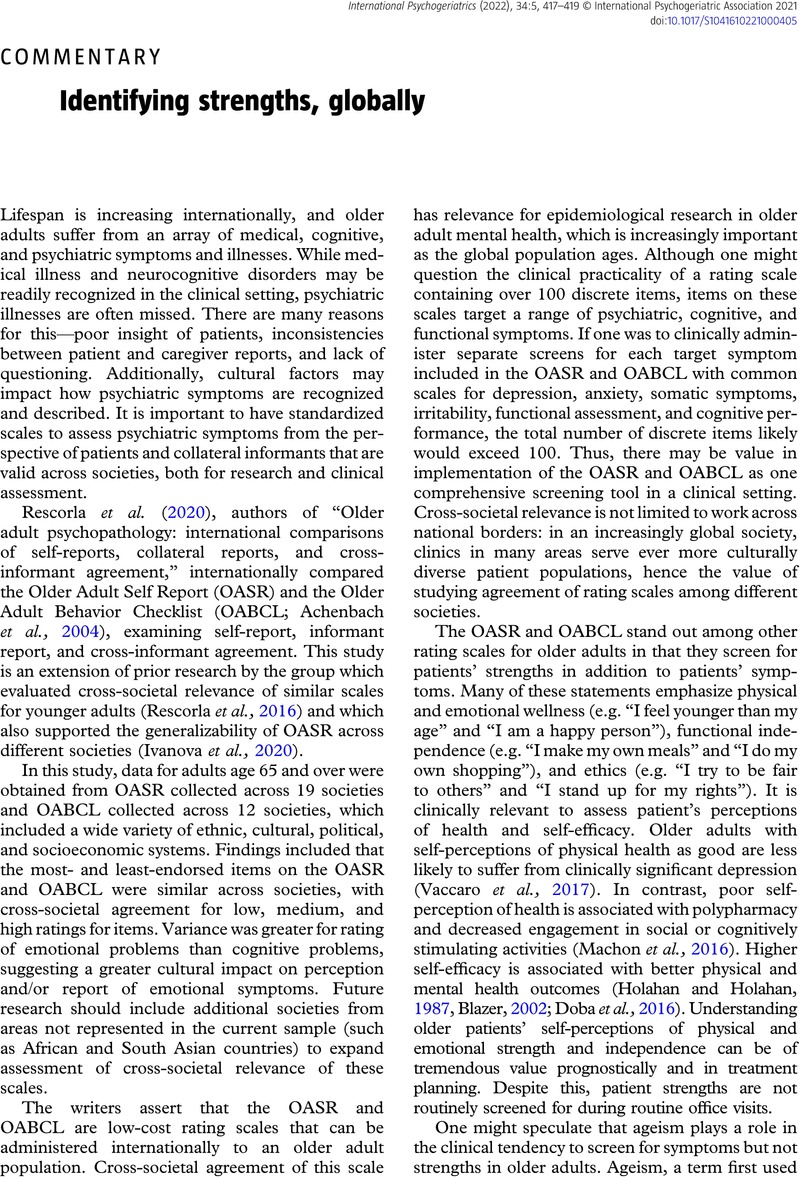No CrossRef data available.
Article contents
Identifying strengths, globally
Published online by Cambridge University Press: 15 June 2021
Abstract
An abstract is not available for this content so a preview has been provided. Please use the Get access link above for information on how to access this content.

- Type
- Commentary
- Information
- International Psychogeriatrics , Volume 34 , Special Issue 5: Issue Theme: Advances in Assessment of Psychopathology , May 2022 , pp. 417 - 419
- Copyright
- © International Psychogeriatric Association 2021
References
Achenbach, T. M., Newhouse, P. A. and Rescorla, L. A. (2004). Manual for the ASEBA Older Adult Forms and Profiles. Burlington, VT: University of Vermont, Research Center for Children, Youth, and Families.Google Scholar
Blazer, D. G. (2002). Self-efficacy and depression in late life: a primary prevention proposal. Aging and Mental Health, 6(4), 315–324.CrossRefGoogle ScholarPubMed
Butler, R. N. (1969). Age-ism: another form of bigotry. Gerontologist, 9(4), 243–246.CrossRefGoogle ScholarPubMed
Cary, L. A., Chasteen, A. L. and Remedios, J. (2017). The ambivalent ageism scale: developing and validating a scale to measure benevolent and hostile ageism. Gerontologist, 57, 27–36.Google ScholarPubMed
Czeisler, M. E., Rashon, I. L., Wiley, J. F., Czeisler, C. A., Howard, M. E. and Rajaratnam, S. M. W. (2021). Follow-up survey of US adult reports of mental health, substance use, and suicidal ideation during the COVID-19 pandemic. JAMA Network Open, 4(2), e2037665.CrossRefGoogle ScholarPubMed
Doba, N., Tokuda, Y., Saiki, K., Kushiro, T., Hirano, M., Matsubara, Y. and Hinohara, S. (2016). Assessment of self-efficacy and its relationship with frailty in the elderly. Internal Medicine, 55(19), 2785–2792.CrossRefGoogle ScholarPubMed
Ehni, H.-J., Wiesing, U. and Ranisch, R. (2021). Saving the most lives—a comparison of European triage guidelines in the context of the COVID-19 pandemic. Bioethics, 35(2), 125–134.CrossRefGoogle ScholarPubMed
Guterres, A. (2020). The impact of COVD-19 on older persons. United Nations Policy Brief. Available at: https://www.un.org/development/desa/ageing/wp-content/uploads/sites/24/2020/05/COVID-Older-persons.pdf; last accessed February 27, 2021.Google Scholar
Holahan, C. K. and Holahan, C. J. (1987). Self-efficacy, social support, and depression in aging: a longitudinal analysis. Journal of Gerontology, 42(1), 65–68.CrossRefGoogle ScholarPubMed
Ivanova, M. Y. et al. (2020). The generalizability of Older Adult Self-Report (OASR) syndromes of psychopathology across 20 societies. International Journal of Geriatric Psychiatry, 35(5), 525–536.CrossRefGoogle ScholarPubMed
Kiosses, D. N. and Sachs-Ericsson, N. (2020). Increasing resilience in older adults. International Psychogeriatrics, 32(2), 157–159.CrossRefGoogle ScholarPubMed
Lorenz, T. (2019). ‘OK Boomer’ marks the end of friendly generational relations. New York Times, October 29, 2019.Google Scholar
Machon, M., Vergara, I., Dorronsoro, M., Vrotsou, K. and Larranaga, I. (2016). Self-perceived health in functionally independent older people: associated factors. BMC Geriatrics, 16, 66.CrossRefGoogle ScholarPubMed
Palmore, E. B. (2004). Ageism in Canada and the United States. Journal of Cross-Cultural Gerontology, 19(1), 41–46.CrossRefGoogle ScholarPubMed
Rescorla, L. A. et al. (2016). Collateral reports and cross-informant agreement about adult psychopathology in 14 societies. Journal of Psychopathology and Behavioral Assessment, 38, 381–397.CrossRefGoogle Scholar
Rescorla, L. A. et al. (2020). Older adult psychopathology: international comparisons of self-reports, collateral reports, and cross-informant agreement. International Psychogeriatrics. doi: 10.1017/S1041610220001532.CrossRefGoogle ScholarPubMed
Sparks, H. (2020). Morbid ‘boomer remover’ coronavirus meme only makes millennials seem more awful. New York Post, published March 19, 2020.Google Scholar
Vaccaro, R. et al. (2017). Subthreshold depression and clinically significant depression in an Italian population of 70-74-year-olds: prevalence and association with perceptions of self. BioMed Research International, 2017, 3592359.CrossRefGoogle Scholar
Vale, M. T., Stanley, J. T., Houston, M. L., Villalba, A. A. and Turner, J. R. (2020). Ageism and behavior change during a health pandemic: a preregistered study. Frontiers in Psychology, 11, 1–12.CrossRefGoogle ScholarPubMed
Wister, A. and Speechley, M. (2020). COVID-19: pandemic risk, resilience, and possibilities for aging research. Canadian Journal on Aging, 39(3), 344–347.CrossRefGoogle ScholarPubMed




